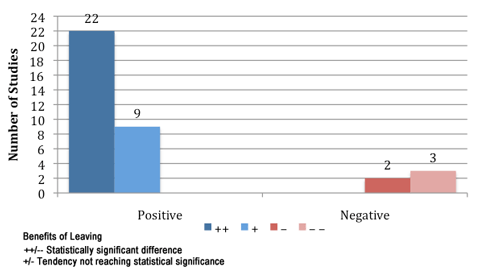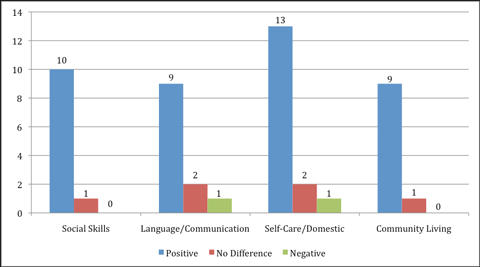Policy Brief Issues
March 2011
The effects of community vs. institutional living on the daily living skills of persons with developmental disabilitiesMarch 2011
The effects of community vs. institutional living on the daily living skills of persons with developmental disabilities
Abstract
A review of 36 studies of outcomes over time for nearly 5,000 people with intellectual and developmental disabilities moving from large institutions to community living arrangements found high consistency in positive change in daily living skills for the movers. Altogether 31 studies indicated positive outcomes as compared with five showing negative outcomes (see Chart 1).Chart 1. Outcomes of Sudies of Changes in Daily Living Skills of Persons with Developmental Disabilieis Leaving Institutions for Community Living

Background
Beginning in 1967 the populations of state institutions for persons with intellectual and developmental disabilities (ID/DD) began to decrease. “State institutions” are defined here as state-operated campuses, buildings or units of buildings with 16 or more residents with ID/DD. In June 1967 there were 194,650 individuals living in state institutions for persons with ID/DD. By June 2009 there were 32,909. As of January 2010 more than half (53.7%) of the 354 state institutions for persons with ID/DD and units specifically for persons with ID/DD ID/DD within other state institutions operating at any time during the previous 50 years had been closed. Eleven states had closed all of the state-operated institutions. These trends which had begun more than 30 years earlier were further supported by the June 22, 1999 decision of the U.S. Supreme Court in Olmstead et al. v L.C. et al. (527 U.S. 581). In its opinion the Court majority concluded that Title II of the Americans with Disabilities Act required states to provide persons with disabilities with community services rather than institutional services when treatment professionals agreed that community services would be appropriate, the individual did not object to a community placement and the community services could be reasonably accommodated within the resources of the State for such services. Because the decision did not establish a universal requirement for community placement and allowed a measure of informed judgment by treatment professionals and state authorities, the evidence-base on the relative benefits and detriments of institutional vs. community placements to persons with ID/DD remains an important issue in policy and practice. This is especially so among those states that have made relatively less progress depopulating their institutions.The question
The question being addressed in this issue of Evidence-Based Policy Brief is: “What are the differential effects of institutional vs. community living on the development of daily living skills (also called adaptive behavior) for persons with intellectual and development disabilities.”
The research method
To conduct this review we used an comprehensive process for identifying high quality studies that compared the relative effects of institutional vs. community living on adaptive behavior. Our search included all US studies published between 1977 and 2010 as identifiable by: a) computer searches of online research data bases in social services and psychology; b) web-based searches using the Google search engine and key words related to the topic; c) manual searches of the 5 primary journals in intellectual and developmental disabilities, d) an ancestry search using the reference lists of all identified research articles and reports, and e) direct requests of studies conducted within the states through contacts with state developmental disabilities program agencies and Developmental Disabilities Planning Councils.
Studies included in the review were ones that had: a) a minimum of 5 subjects who moved from institutional to community settings in 1975 or later; b) a description of the demographic and diagnostic characteristics of people in the sample; c) a sample made up primarily of adults; d) baseline data gathered while subjects were still residing in an institution or within one month after leaving; e) post-move outcome data gathered no less than 6 months after leaving the institution; and f) data reported on overall adaptive behavior or specific domains of adaptive behavior that were gathered in the same manner with the same instruments in both the pre-and post move assessments.
The evidence
A total of 45 studies were identified that met the criteria of inclusion. These included 17 studies in which changes in general or specific skills of daily living were compared for people leaving institutions with changes over the same period of matched groups of stayers. The identified studies also included 31 that assessed daily living skills of people before they left the institution and then reassessed the presence of those same skills 6 or more months after their move to the community. Three of these studies included both a comparison group and longitudinal follow-up of the same individuals.
Adaptive behavior
Altogether 36 studies looked at general “adaptive behavior” that is, a composite scale from ratings on a wide range of daily living skills. These studies shown in Chart 1 (page 1) included 31 that showed positive outcomes associated with moving from institutions as compared with 5 showing negative outcomes. When screened for statistical significance with the standard of less than a 5% chance that the result was because of sampling error, there were 25 qualifying studies identified. Of these 22 showed significantly better outcomes associated with community living as compared with 3 with that showed better outcomes associated with living in institutions.
In addition to the studies of changes in general adaptive behavior, 21 studies examined relative benefits of moving to the community in specific areas of daily living. These studies included 10 studies of the outcomes for movers compared with those of matched stayers and 11 studies that followed the same individuals from institution living through 9 to 84 months of community living. A total of 75 comparisons made in seven skill areas of daily life (i.e., academic, community living, language/ communication, physical, self-care and domestic, social and vocational skills). Of these 64 (85%) indicated benefits of the move to the community; 4 (5%) indicated detriment in skill development as a result of the move; and 7 (10%) showed no difference. Among the 44 comparisons reaching the 95% standard of confidence in the result, 41 (93%) showed statistically significant differences favoring the move to the community; 7% showed more positive outcomes associated with institutional life. Chart 2 summarizes the results of the analyses in the 4 most frequently studied areas: a) social skills, b) language/communication skills, c) self-care/domestic skills, and d) community living skills.
Chart 2. Outcomes of studies of change in Social, Communication, Self-Care/Domestic and Community Living Skills of Persons with Developmental Disabilities Moving from Institution to Community

In all, the findings of these studies of outcomes in specific areas of daily living skills are highly consistent with the assessments of general daily living skills. Importantly, the strong tendency toward better outcomes in the community was evident not only in the areas in which they might be most expected (e.g. self-care and domestic skills, and community living skills), but were also in areas that might be considered less directly related to living in a home in the community (e.g., language and communication skills and social skills).
The studies reviewed also included 31 comparisons of changes in challenging (problem) behavior associated from moving from institutions to community living arrangements. These comparisons were much less consistent in showing positive outcomes associated with a move to the community.
Challenging Behavior
Of 26 studies that assessed changes in overall challenging behavior, 14 found positive effects of the move, 10 found negative effects and 2 found no difference. Statistically significant differences were found in only 8 of the 26 studies (5 showing positive effects of the move, 3 showing negative). Seven studies specifically addressed externally directed challenging behavior (e.g. aggression, disruption). Of these 6 of the 7 showed positive outcomes associated with moving to homes in the community, but only two of these reached statistical significance. Of the 6 studies that addressed internalized challenging behavior (e.g., self-injury, withdrawal) 4 found positive effects associated with moving to the community, 1 found negative effects and 1 found no difference. Only 3 of these studies (2 positive and 1 negative) reached statistical significance.
Discussion and implications
There is a high preponderance of evidence that individuals moving from institutional to community settings consistently develop their daily living skills (adaptive behavior) to a higher level than their matched peers who remain institutionalized and/or that they themselves had developed prior to leaving the institutional settings. The consistency of these findings is notable and rare in social research. As an example of the strength and consistency of these findings, a highly influential review published in Consumer Reports in 1995 prompted major initiatives to limit exposure to secondhand smoke in the US. That review reported on 33 studies of the association of exposure to secondhand smoke with lung cancer. It found that 26 (79%) of the studies reported positive associations, 7 of which obtained statistical significance. Among the studies reviewed in this brief 36 studies of the association between leaving institutions and improved adaptive behavior development, 31 (86%) found positive associations, 22 of which obtained statistical significance.
Each year, states and federal governments invest billions of dollars in “active treatment” in Medicaid ICF/MR programs, and in “habilitation” services provided in Medicaid Home and Community Based Services. They do so recognizing not only a right to treatment of persons with developmental disabilities in residential programs, but also the predictable benefits to individuals and the public when people learn to live more independently. In pursuit of efficiency and cost-efficiency in treatment and habilitation, research demonstrates clearly and overwhelmingly that community living is a substantially more effective approach to assisting people to achieve their potential in living independently than the care that occurs in institutional environments.
In 1999 the U.S. Supreme Court recognized that the Americans with Disabilities Act and its regulations established a right to a life in the community and an end to the isolation and segregation that is inherent to institutionalization. The Court did provide however that should treatment professionals judge community placement detrimental, right to a place in the community might legally be denied. The studies of daily living skills differentially acquired in life in the community as compared with institutional living should be foundational to the exercise of such professional judgment, as it should be to establishing public policies that are consistent with individual well-being. To overlook such substantial and consistent findings cannot be easily justified in either public policy or treatment practices.
Source for the Research Review and Full Reference List
- Lakin, K.C., Larson, S. A., Kim, S. (2011). Behavioral outcomes of Deinstitutionalization of People with Developmental Disabilities: Third Decennial Review of Studies, 1977-2010. Policy Research Brief, 22 (1)
- See also: Consumer Reports (1995). Secondhand smoke: Is it a hazard? Consumer Reports 20 (1), 27-33.
- Additional information related to this topic: For national and state-by-state information on residential services for persons with ID/DD (institutional and community), please visit the website for the Residential Information System Project (RISP). It provides the most recent report of data on residential and Medicaid services from the Residential Information System Project. It also provides access to the Project’s Build a Report function that allows menu driven comparisons of the status and trends in state and national services. RISP is supported by the Administration on Developmental Disabilities, with supplemental support from the National Institute on Disability and Rehabilitation Research.
